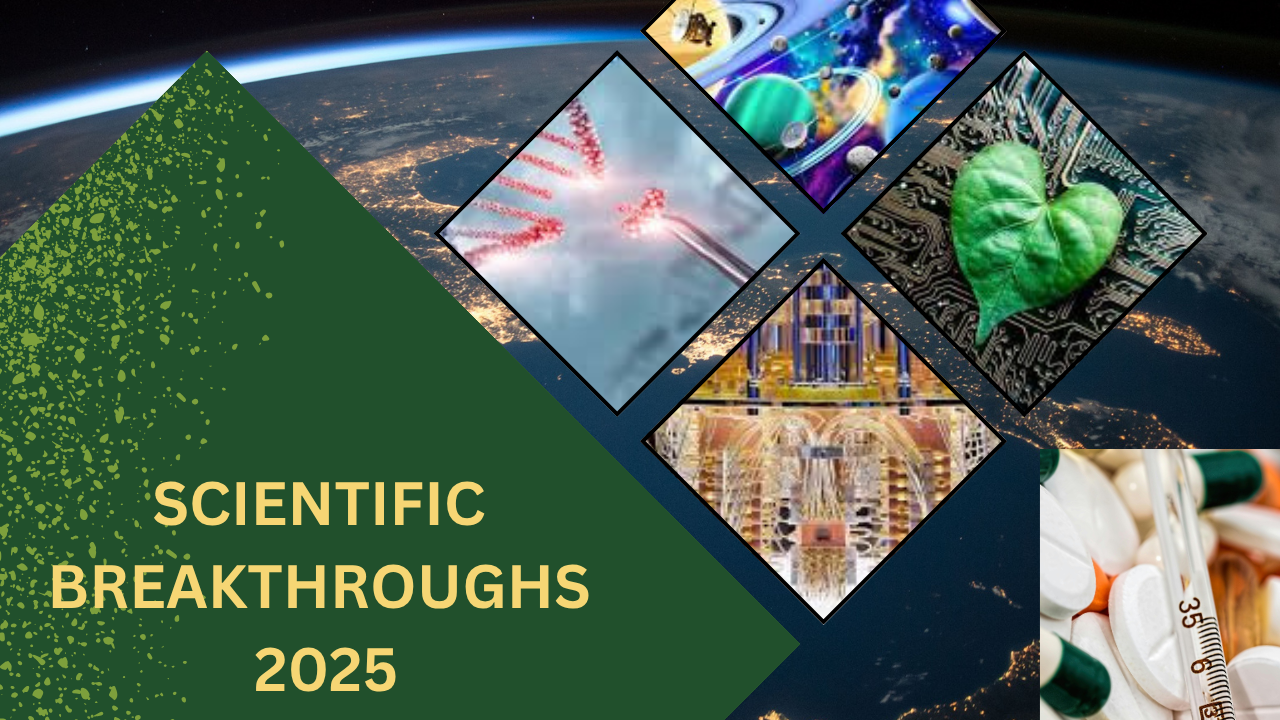As we look towards scientific breakthroughs in 2025, we can anticipate advancements building upon current trends in diverse fields, promising to solve complex global challenges and open up unprecedented avenues for human development. This year is poised to bring significant leaps in areas such as personalized medicine, driven by refined gene-editing technologies and deeper understanding of individual biologies, offering new hope for intractable diseases.
We can also expect further progress in sustainable energy solutions, with innovations in battery storage, fusion research, and more efficient renewable energy capture, potentially transforming global power grids. Furthermore, artificial intelligence, particularly in its applications to scientific discovery and complex problem-solving, will likely accelerate, pushing the boundaries of what's possible in material science, climate modeling, and beyond, paving the way for a healthier, more sustainable, and technologically advanced future.

The Nature of Scientific Breakthroughs and Ongoing Progress
Scientific breakthroughs are not merely incremental steps; they represent significant leaps that often fundamentally alter existing paradigms or create entirely new fields of study. They are the pinnacles of scientific progress, emerging from countless hours of research, experimentation, and often, and serendipitous observation. These new discoveries are typically characterized by their novelty, their profound implications for theory or application, and their ability to inspire further inquiry.
The journey of scientific progress is cumulative. Today's scientific breakthroughs are built upon the recent scientific discoveries of yesterday, which in turn rely on foundational knowledge accumulated over centuries. For example, advancements in artificial intelligence are rooted in decades of computer science and cognitive research, while CRISPR gene editing technology leverages fundamental insights from microbiology and genetics. This interconnectedness means that scientific progress is a complex web of interconnected findings, where a breakthrough in one area can catalyze rapid developments in many others.
Anticipating Scientific Breakthroughs in 2025
While predicting specific scientific breakthroughs in 2025 is inherently speculative, we can project based on current intensive research fronts and areas showing rapid scientific progress:
- Advanced AI and Machine Learning
- Gene Editing and Cell Therapies
- Sustainable Energy Solutions
- Space Exploration and Astronomy
- Quantum Computing
1. Advanced AI and Machine Learning
Expect significant strides in large language models, multimodal AI (processing text, images, and audio simultaneously), and AI for scientific discovery. Scientific breakthroughs in 2025 could include AI systems demonstrating more robust common sense reasoning, or revolutionizing drug discovery by predicting molecular interactions with unprecedented accuracy. The integration of AI into scientific experimentation itself is a major area of scientific progress.

2. Gene Editing and Cell Therapies
Building on the foundations of CRISPR, new discoveries in gene editing might lead to more precise, safer, and broader applications for treating genetic diseases like cystic fibrosis or Huntington's. Advances in cell therapies could offer more effective treatments for cancers and autoimmune disorders, potentially offering personalized medicine solutions.
3. Sustainable Energy Solutions
With global climate challenges pressing, scientific breakthroughs in 2025 are likely to focus on more efficient solar energy conversion, advanced battery technologies for energy storage, and perhaps even early milestones in practical fusion energy research. These new discoveries are critical for global sustainability.

4. Space Exploration and Astronomy
Missions planned for 2025 could bring new discoveries from the Moon, Mars, or deep space. Further analysis of exoplanet atmospheres might reveal more Earth-like worlds, fueling hopes for extraterrestrial life. Scientific breakthroughs in propulsion systems or in-space manufacturing could also see early demonstrations.

5. Quantum Computing
While still in its early stages, scientific progress in quantum computing continues at a rapid pace. Scientific breakthroughs in 2025 might involve achieving quantum supremacy for increasingly complex problems or developing more stable and error-resistant qubits, moving closer to practical quantum applications in cryptography or material science.

How to Follow Scientific Breakthroughs in Real-Time
To effectively follow scientific breakthroughs and recent scientific discoveries in such a dynamic environment, a multi-pronged approach is essential:
- Leading Scientific Journals
- Preprint Servers
- Reputable Science News Outlets
- University and Research Institution Newsrooms
- Scientific Conferences
- Social Media and Expert Accounts
1. Leading Scientific Journals
Subscribing to or regularly checking the websites of premier interdisciplinary journals is paramount. The Nature journal is a prime example, alongside Science and Cell, which consistently publish groundbreaking new discoveries. Many of these offer email alerts for new issues or specific topics, making it easier to follow scientific breakthroughs. While access can be expensive, leading to the phrase “buy scientific paper,” many universities and research institutions provide subscriptions, and the Open Access movement is increasingly making research freely available.
2. Preprint Servers
For the absolute earliest look at scientific progress, platforms like arXiv, bioRxiv, and medRxiv are invaluable. These servers host research papers before formal peer review, offering a rapid glimpse into new discoveries as soon as they are complete. While not yet vetted, they provide a crucial window into scientific breakthroughs in their nascent stages.
3. Reputable Science News Outlets
Major publications like Scientific American, New Scientist, MIT Technology Review, and the science sections of prominent newspapers (e.g., The New York Times, The Guardian) often translate complex scientific breakthroughs into accessible language for a broader audience. These are excellent resources to follow scientific breakthroughs without delving into every technical detail.
4. University and Research Institution Newsrooms
Many universities, especially those involved in significant US research, maintain newsrooms or blogs that highlight their new discoveries and scientific progress. Following these institutions can provide direct insights from the source.
5. Scientific Conferences
Major conferences (e.g., AAAS Annual Meeting, specific discipline-focused symposia) are where new discoveries are often first presented and discussed among peers. Following their agendas and social media discussions can help follow scientific breakthroughs as they unfold.
6. Social Media and Expert Accounts
Many leading scientists, journalists, and research institutions use platforms like X (formerly Twitter) or LinkedIn to share immediate updates, links to new discoveries, and commentary on scientific breakthroughs.
The Indispensable Role of US Research in Global Scientific Progress
The US research landscape remains a global leader in driving scientific progress and generating new discoveries. This is largely due to:
- Robust Funding
- World-Class Institutions
- Collaborative Ecosystems
- Technological Infrastructure
1. Robust Funding
Government agencies like the National Institutes of Health (NIH) and the National Science Foundation (NSF), alongside private foundations and industry, provide substantial funding for research across a vast array of disciplines. This investment is crucial for enabling ambitious projects that lead to scientific breakthroughs.
2. World-Class Institutions
The US is home to numerous top-tier universities and research institutions (e.g., Harvard, Stanford, MIT, Caltech) that attract leading scientists and foster environments conducive to new discoveries and scientific progress.
3. Collaborative Ecosystems
The US research environment often facilitates interdisciplinary collaboration, bringing together experts from different fields to tackle complex challenges, thereby accelerating the pace of scientific breakthroughs.
4. Technological Infrastructure
Access to cutting-edge facilities, supercomputing power, and specialized equipment allows US research to push the boundaries of experimental science and data analysis, leading to profound new discoveries.
Conclusion
As we anticipate scientific breakthroughs in 2025 and beyond, it is clear that scientific progress is an ongoing, dynamic process of new discoveries that continuously expands the limits of human knowledge and capability. To effectively follow scientific breakthroughs, it's crucial to engage with both formal publications (like Nature journal), informal channels (like preprints), and the broader scientific community, including the vibrant US research landscape. While the desire to “buy scientific paper” for immediate access highlights existing challenges, the push towards open science and the dedication of countless research efforts ensure that the fruits of scientific progress continue to be shared, analyzed, and built upon, ultimately benefiting all of humanity. The year 2025 will undoubtedly contribute its unique set of new discoveries to this grand tapestry of scientific progress.









